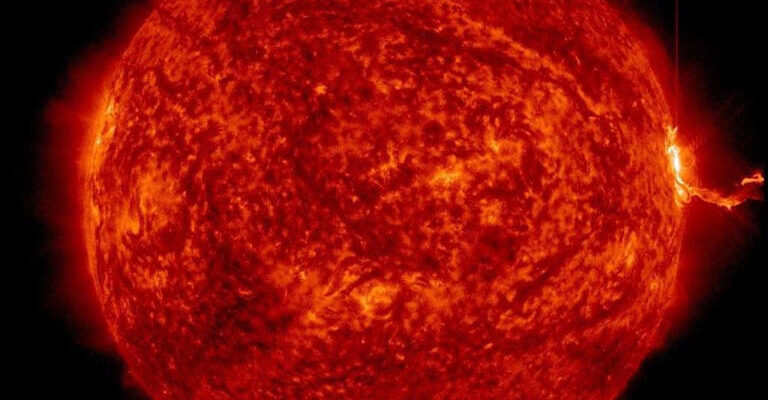September 28, 2025
Our celestial neighbor, the Sun, recently reminded us of its formidable power with an M6.4 class solar flare, marking the most potent eruption observed in the last three months. This energetic event, registered by scientists monitoring solar activity, has reignited discussions about space weather and its far-reaching implications for Earth`s systems.
A Sudden Surge of Solar Power
On September 28, a significant impulsive solar flare of M6.4 class erupted from the Sun`s eastern limb. Data from the Laboratory of Solar Astronomy at a leading Space Research Institute indicated that the peak energy release, measured through X-ray emissions, occurred around 11:43 AM Moscow time (8:43 AM UTC). For context, M-class flares are considered medium-sized but can still cause brief radio blackouts and minor radiation storms. An M6.4, while not in the most extreme X-class category, is certainly enough to get the attention of space weather forecasters and ground controllers.
“At the Sun`s eastern edge today, around noon, an impulsive M6.4 class flare was registered. The maximum energy release, according to solar X-ray measurements, peaked at 11:43 MSK.”
This powerful eruption follows a period of escalating solar activity. Just the day prior, nineteen flares were recorded, including three lower-magnitude M-class events. This flurry of activity had initially led some observers to speculate that the Sun`s current energy reserves might be waning. However, the M6.4 flare decisively countered that assessment, confirming that our star still has plenty of surprises left in its arsenal.
Earthly Repercussions: More Than Just Pretty Lights
When the Sun sneezes, Earth often catches a cold – or at least a significant electromagnetic disturbance. Solar flares, especially those of M-class and higher, are precursors to phenomena known as geomagnetic storms. These storms occur when charged particles and magnetic fields from the Sun slam into Earth`s magnetosphere, causing temporary disruptions.
Impacts We Feel Down Below:
- Power Grid Instability: Geomagnetic storms can induce currents in long conductors, leading to voltage irregularities and, in extreme cases, blackouts in industrial power grids. While rare, major events have caused widespread power outages.
- Radio Communication Disruptions: Shortwave radio communications, vital for aviation, shipping, and emergency services, are particularly vulnerable. High-frequency signals can be absorbed or scattered by the ionosphere, leading to temporary radio blackouts.
- Navigation System Interference: Satellite-based navigation systems, like GPS, rely on precise timing and signal paths. Geomagnetic activity can distort these signals, causing errors or temporary outages for users globally. Your daily commute might not be affected, but precision agriculture or defense applications certainly could be.
- Migratory Pattern Shifts: Nature, ever-sensitive, also feels the Sun`s temper. Scientists have long observed that geomagnetic storms can interfere with the navigational abilities of birds and animals that rely on Earth`s magnetic field for migration.
- Spectacular Auroras: Perhaps the most visually stunning, and ironically, often the only “positive” side effect for the general public, is the increased visibility of the aurora borealis (Northern Lights) and aurora australis (Southern Lights). These celestial light shows, usually confined to polar regions, can extend much closer to the equator, offering breathtaking displays for millions. While we appreciate the cosmic fireworks, it`s worth remembering they`re a side effect of a potentially disruptive event.
- Human Health: For those concerned about personal well-being, current scientific understanding indicates there is no conclusive evidence that magnetic storms directly impact human health. So, while your gadgets might occasionally falter, your internal systems are likely to remain unperturbed.
The Enduring Solar Cycle
This M6.4 flare is a stark reminder that the Sun is not a static entity but a dynamic star constantly undergoing a roughly 11-year cycle of activity. We are currently in a period of increasing activity, heading towards the next solar maximum. Such flares are expected to become more frequent and more powerful as the cycle progresses.
Scientists around the globe, including those from the aforementioned Space Research Institute, dedicate countless hours to monitoring these solar events. Their work is crucial for developing accurate space weather forecasts, which in turn allow industries and governments to prepare for potential disruptions. From safeguarding astronauts and satellites to ensuring the stability of power grids on Earth, understanding our Sun`s moods is an increasingly critical endeavor in our technology-reliant world.
Conclusion
The M6.4 solar flare of September 28, 2025, serves as a powerful demonstration of the Sun`s influence on Earth. While the immediate consequences might range from a dazzling aurora to minor technological hiccups, it underscores the continuous need for vigilance and research in space weather. As our technology becomes more intertwined with space, so too does our vulnerability to the whims of our very own star.




